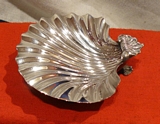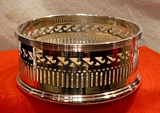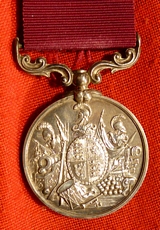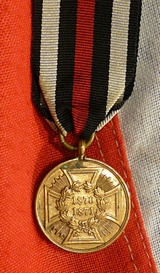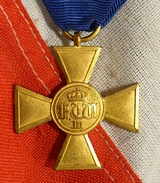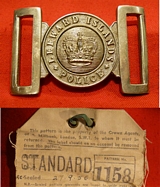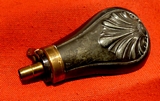Two Field Dressings WW2 British Army Issue.
Unwrapped and in excellent condition. read more
20.00 GBP
A Very Fine Mid 19th Century Silver Plated Shell Dish, Set on 3 Feet.
In superb condition, probably made by Elkington and Co. Beautifully crafted and of sublime quality. 5 x 5 x1,5 inches read more
175.00 GBP
A Nice Early 19th century, King George IIIrd Old Sheffield Decanter Coaster
a wine and spirit decanter gallery coaster in fine old plate, with deep turned carved mahogany base, pierced sides, multi ribbed rim edge and beize cloth on the bottom. Measures 5" in diameter x 2.25" tall. Excellent period condition. read more
220.00 GBP
A Very Fine Victorian Long Service Good Conduct Medal
Awarded to a Battery Quarter Master Sergeant in the Royal Field Artillery, the 1873 issue Medal. read more
185.00 GBP
The German Franco Prussian War Commemorative Medal of 1870/71
this is a campagian medal presented by Kaiser William I in his capacity as King of Prussia. The medal was presented to commemorate recipents service in the Franco Prussian War. The medal was presented to members of the united German armies. The medal was presented for combat service in gilt bronze, and non-combat service in steel. Each version bore minor differences in inscription and design. Claps were authorized on the 25th anniversary of the German victory, to commemorate selected battles. read more
75.00 GBP
A Stunning Prussian, 25 Year Gold Medal In Gilt Bronze
With original silk ribbon. In superb pristine coindition awarded in WW1. read more
155.00 GBP
A Unique 'Sealed Pattern' Leeward Islands Police Buckle
In excellent condition. With Crown Agents 'sealed pattern' label. The sealed pattern buckle was the very first dgovernment approved buckle of it's type, and the example by which every other one must follow. read more
150.00 GBP
A Superb 19th Century Britannia Metal and Brass Mounted Pistol Flask
A lovely flask, perfect for a set of cased pistols or a cased revolver etc. lacking a good flask. Excellent condition, with very good original gold lacquer finish to the brass. 4 inches long 2 inches across. Very small dent at the bottom on one side about 10mm x 5mm read more
295.00 GBP
We Constantly Seeking Items From Airships, RFC, Zeppelin & Balloon Corps.
Please contact us if you wish to sell any items from the WW1 Royal Flying Corps, the Imperial German Air Force, the German Airships, Balloons and Zeppelins. Anything related to the Luftschiff read more
Price
on
Request
Armouryantiques and militaria
The best militaria shop in the UK A Superb Case Hardened Steel Gun Lock Of a Greene Carbine 1856 Scarce British-Type Greene Carbine by Massachusetts Arms Company
Case-hardened swivel breech action with Maynard tape primer system. Lock marked: Queen's crown /VR/Mass.Arms Co./U.S.A./1856.
James Durell Greene was a prolific firearms inventor and determined to make his mark This carbine lock was manufactured by the Massachusetts Arms Company and exported to Great Britain after being inspected and stamped with the Queen's Crown by British inspectors in the USA. These were used by the British Cavalry in the Crimean War but re-exported to the USA after the Crimea War. These fine guns were deemed to be very accurate but the paper and linen cartridges of the time were criticised as being prone to swell in the damp and consequently the carbine did not find favour with the British Government. The carbine features an unusual "floating thimble" to obdurate the breech and an internal "pricker" that punctured the cartridge. It also featured Maynard Tape priming which was in the forefront of priming technology at the time and the mechanism for this is in perfect condition. The quality of workmanship is exceptional and it actions as crisply today as it did when it was made 158 years ago.
An exceptional item in outstanding condition. Only 2000 were manufactured and a complete carbine would be around ?3,000. read more
Price
on
Request



